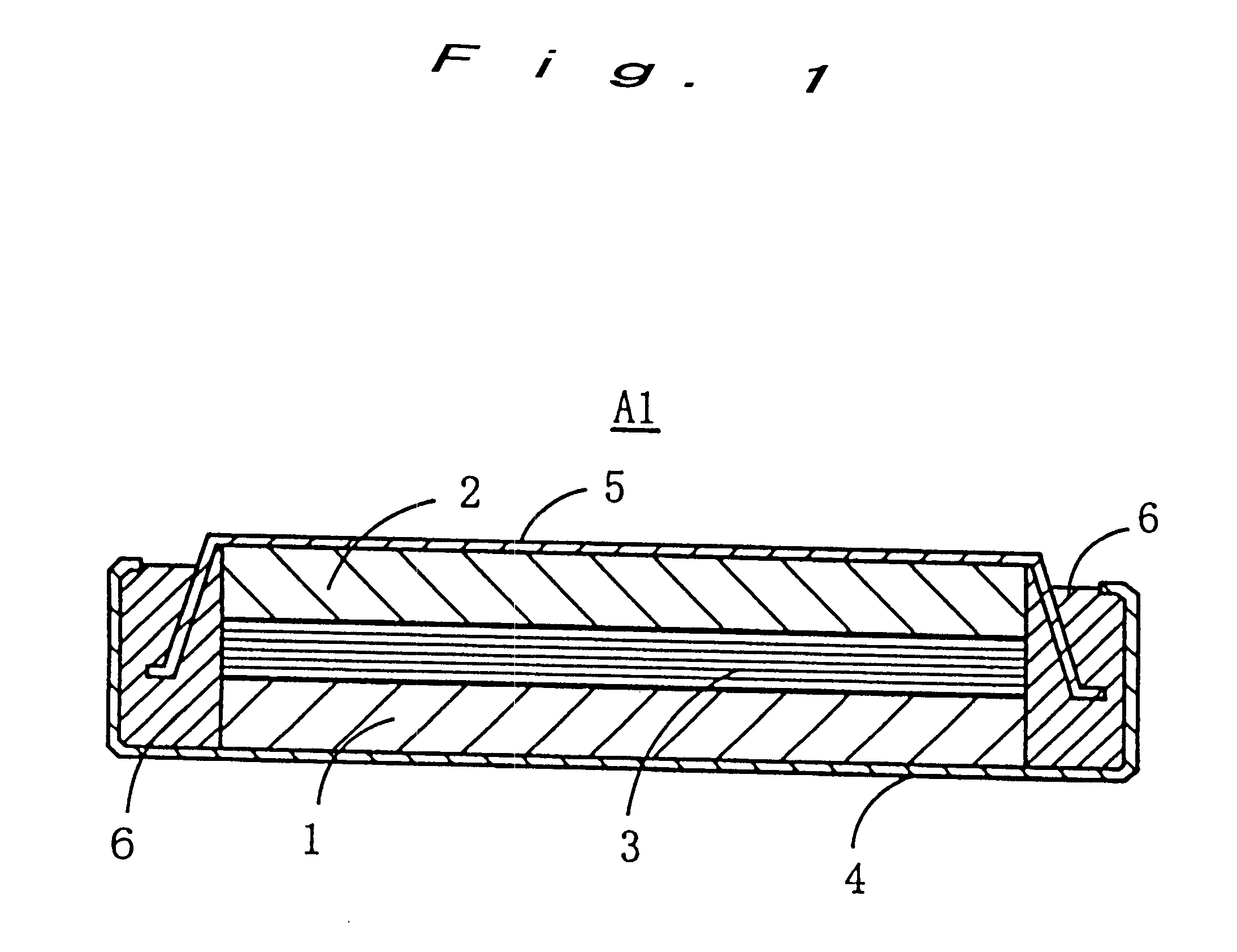Lithium secondary battery
a secondary battery and lithium technology, applied in the field of lithium secondary batteries, can solve the problems of poor charge-discharge cycle performance, small discharge capacity, and high cost of positive electrode materials, and achieve the effects of reducing the strain of the crystal structure, stable crystal structure, and reducing the strain of the ordering energy
- Summary
- Abstract
- Description
- Claims
- Application Information
AI Technical Summary
Benefits of technology
Problems solved by technology
Method used
Image
Examples
embodiment 1
Preparation of Positive Electrode
Manganese acetate (Mn(CH.sub.3 COO).sub.2), nickel nitrate (Ni(NO.sub.3).sub.2) and magnesium acetate (Mg(CH.sub.3 COO).sub.2) were mixed in a molar ratio of 1.55:0.40:0.05, the thus obtained mixture was added to a 50 vol % ethyl alcohol aqueous solution and the resultant was stirred. To this solution, 30 vol % aqueous ammonia was added to give a precipitate. The precipitate was mixed with lithium nitrate (LiNO.sub.3) in an atomic ratio between the total amount of Mn, Ni and Mg and the amount of Li of 2:1. The resultant mixture was baked in an oxygen atmosphere at 700.degree. C. for 20 hours, then cooled to room temperature and crushed with a jet mill. Thus, a lithium-containing manganese composite oxide (positive electrode active material) having a median diameter of 10 .mu.m and represented by a formula, LiMn.sub.1.55 Ni.sub.0.04 MgO.sub.0.05 O.sub.4, was prepared. The median diameter was obtained by laser diffraction (all median diameters mentione...
embodiments 2 through 7
Six kinds of lithium-containing manganese composite oxides (LiMn.sub.1.55 Ni.sub.0.40 M.sub.0.05 O.sub.4, wherein M is Fe, Co, Zn, Ga, Nb or Mo) with a median diameter of 10 .mu.m were prepared in the same manner as in Embodiment 1 except that magnesium acetate was replaced with iron nitrate (Fe(NO.sub.3).sub.3), cobalt acetate (Co(CH.sub.3 COO).sub.2), zinc nitrate (Zn(NO.sub.3).sub.2), gallium nitrate (Ga(NO.sub.3).sub.3), niobium chloride (NbCl.sub.5) or molybdenum chloride (MoCl.sub.5) in the same molar ratio. All of these lithium-containing manganese composite oxides were confirmed through the X-ray powder diffraction method to have a single phase structure corresponding to a spinel structure.
These lithium-containing manganese composite oxides were respectively used as positive electrode active materials for fabricating present batteries A2 through A7, which are different from the present battery A1 in the positive electrode active material alone.
embodiments 8 through 10
Three kinds of lithium-containing manganese composite oxides (LiMn.sub.1.55 Ni.sub.0.40 M.sub.0.05 O.sub.4, wherein M is Ti, V or Cu) with a median diameter of 10 .mu.m were prepared in the same manner as in Embodiment 1 except that magnesium acetate was replaced with titanium chloride (TiCl.sub.4), vanadium chloride (VCl.sub.3) or copper nitrate (Cu(NO.sub.3).sub.2) in the same molar ratio. All of these lithium-containing manganese composite oxides were confirmed through the X-ray powder diffraction method to have a single phase structure corresponding to a spinel structure.
These lithium-containing manganese composite oxides were respectively used as positive electrode active materials for fabricating present batteries A8 through A10, which are different from the present battery A1 in the positive electrode active material alone.
PUM
| Property | Measurement | Unit |
|---|---|---|
| median diameter | aaaaa | aaaaa |
| median diameter | aaaaa | aaaaa |
| temperature | aaaaa | aaaaa |
Abstract
Description
Claims
Application Information
 Login to View More
Login to View More - R&D
- Intellectual Property
- Life Sciences
- Materials
- Tech Scout
- Unparalleled Data Quality
- Higher Quality Content
- 60% Fewer Hallucinations
Browse by: Latest US Patents, China's latest patents, Technical Efficacy Thesaurus, Application Domain, Technology Topic, Popular Technical Reports.
© 2025 PatSnap. All rights reserved.Legal|Privacy policy|Modern Slavery Act Transparency Statement|Sitemap|About US| Contact US: help@patsnap.com

